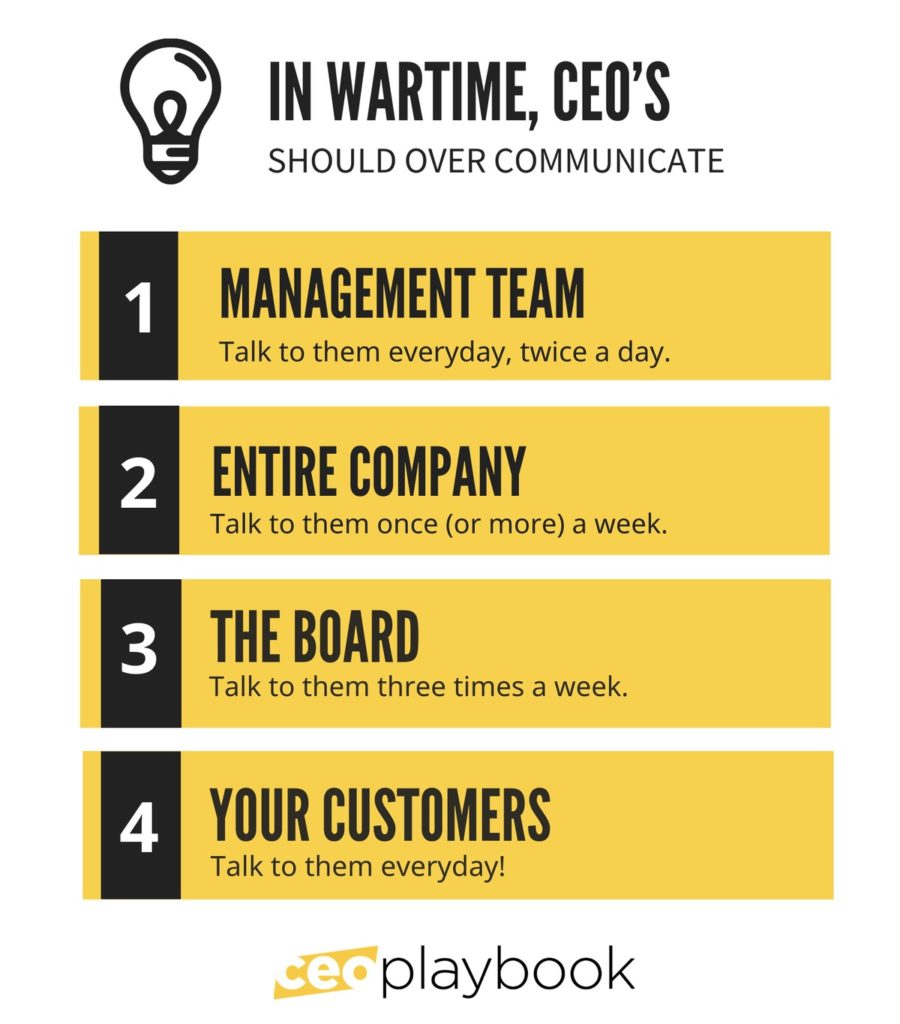Who would have thought— in a short two decades, we would see so many huge catastrophes — the dot-bomb, 9/11, Hurricane Katrina, 2008 financial crisis, Hurricane Sandy, Trump, and Coronavirus!
I have lived through every single one as an entrepreneur and operator.
I remember, in vivid detail, the dot-com collapse, 9/11, and the 2008 financial crisis.
With each one of these events, I witnessed both the collapse of business-as-usual and I gained the resilience it takes to recover from them.
Coronavirus is a new opportunity to rise as a CEO.
It is an event like no other.
“The coronavirus outbreak is economically akin to a major hurricane occurring in every state around the country for weeks on end,” said Daniel Zhao, a senior economist at Glassdoor.
You are now at war—a war for survival.
If this is your first time in a crisis, then here is a list of the plays that will be critical to navigating the new battlefield you are now on.
 You can listen to this Article on the #CEO Podcast, HERE.
You can listen to this Article on the #CEO Podcast, HERE.
1–Make small decisions first
You will be quickly overwhelmed by frantic calls from customers, employee emails filled with anxiety, and chilling silence from your sales prospects.
Do not rush to make big, sweeping decisions too quickly.
If the crisis is a fruit tree, grab the apples closest to you and munch on those first.
(If your kids are a fan of Disney’s Frozen 2, take a page out of Grand Pappie’s book, “When one can see no future, all one can do is the next right thing.”)
2–Take care of your people.
Especially in the face of this pandemic, your priority is the health of your people. Get them out of the office if you haven’t done so.
Check-in with each of them to ensure they are taking the necessary steps to keep their families safe and support them when you can.
Show empathy for the emotional toll this particular crisis will have on your people.
During 9/11, many people suffered from an overwhelming amount of fear. During the 2008 financial crisis, people were anxious. The Coronavirus pandemic is a combination of both. About everyone will likely have direct or indirect exposure to COVID-19.
(I am experiencing it first-hand as members of my extended family and my mom suffer from it.)
So, don’t be quick to problem solve. Take a deep breath and hug your people, be accessible, and show humanity.
Also, in due time you may be asking some of them to leave the company. Remember to do it with grace. Don’t schedule a giant Zoom call to deliver a group “pink sheet.”
The universe has a long memory.
3–Take care of your customers
Make a list of each of your customers from largest to smallest and call each one.
If you need to, break up the task among your management team.
Unfortunately, you can’t travel for face-to-face meetings during this pandemic. Make those video calls so you can see their faces. Read the emotions of your sponsors to get a real feel for what is going on. Getting this sense is critical.
Make sure your customer’s critical systems are up and running as best you can. Reassure them that you can support them through this crisis.
Do your best to assess where they are in their internal planning process.
Get them to agree to regular check-ins to ensure you have a bright line of sight into their financial and operational situation.
Ideate with your customers on how you might address their pressing needs right now.
Then, remind them–the people you are speaking to–to breathe.
After those calls, mark each customer as red, yellow, or green.
Remove the red ones from your forecast and cut the yellow ones by at least 50%. As harsh as this sounds, it is a must.

4–Focus on liquidity
Calculate your cash break-even point.
First, assume the worst-case scenario. Assume you close no new deals, and your customer’s forecasts shrink by at least 50%. Again, pull the red customers out of the plan and drop the yellows by a lot.
Second, reduce your operating expenses big time.
Start with staff reductions.
As difficult as this part of the equation will be–believe me I have been there–you must start with it because it is the most powerful tool. And, begin reducing staff in every department until there is barely any meat on the bone.
You’ll need to cut deeper than you think.
In my experience, one super deep cut is much better than multiple smaller reductions. Don’t let your management team or CFO present you with a reduction plan that does not include people (i.e., cutting travel or T&E, event budgets only). That’s a typical play and useless to you right now.
In the past, I gave each department lead a target percentage reduction they must reach. When they return with the plan, I always ask, “how many people did you cut?” If the answer is zero, I send them back to the drawing board.
The emotional toll and the reality of the situation will demand more cuts, no matter what. It’s better, therefore, to plan for the worst.
Here is a proven recipe for implementing a staff reduction when disaster strikes.
One important thing, when the final list of cuts is ready, you must own it. Review every name and make it clear in your communication to the team, that this decision was yours. You are the CEO and responsible for making these difficult decisions.
Then when you’ve done all this work, be incredibly frugal from there on out. You need to survive for at least 18-months before you need to raise capital again.
5–Innovate in every way possible
There are no ideas off the table during wartime. You are in survival mode.
- Can you change your pricing?
- Can you pivot and enter a new business line?
- Can you turn engineering or product people into revenue-generating consultants?
- Can you outsource part of your offering to a partner?
- Can you have your conferences virtually?
- Can you change your commission plan to an MBO plan?
- Can you close the shop for a while and wait it out?
- Can you [insert idea from anywhere in the company and beyond]?
The answer to these questions is yes.
Anything that can give your business a lifeline is on the table.
Encourage your management team–what’s left of them– to develop as many ideas as possible. Then send them “home” to produce more.
There is no end to the list.
6–Maintain connections and culture digitally
During the Coronavirus, you have the new challenge of social distancing and work-from-home requirements.
While it is key to stopping the virus from overtaking our healthcare system, it is possibly a culture killer.
How do you maintain your culture and core values during these challenging times?
The answer depends on your company. But, it is clear that you, as CEO, need to make a priority to fight for the survival of your culture.
As Tony Hsieh, founder of Zappos, says, “protecting the company culture and sticking to core values is a long-term benefit.”
He’s lived through a few crises of his own.
The core values and culture of your company are future-proof, pandemic-proof, recession-proof, but only if you invest in protecting them.
Live your values and amplify your culture in these challenging times.
7–Increase communication frequency (company-wide) with no BS
As CEO, I made a habit of speaking with my employees with a well-defined schedule.
Like clockwork, I would have a quarterly all-hands, a bi-weekly internal blog article, monthly update emails, and conference calls. I would even take random walks around the office to get a read on what was happening.
During wartime, communication must go into hyperdrive.
I am talking about daily calls with the team providing up to date information about the status of the company, what you see as the most significant challenges, and what you are doing to push through them.
One extremely important thing: don’t sugar coat things.
No bullsh*t. No happy talk.
“Whether you’re the leader of a company or a country, the problem with Happy Talk is that you can’t get out of a crisis until you admit you’re in one. Once you admit it, you can fix it. If you try to sugarcoat it, you can’t explain why people need to take the tough steps and make sacrifices. Trying to make people feel better by under-selling the problem or over-selling personal assurances never works. It just makes the team feel worse. Leaders only make people feel better by clearly stating the problem, providing a credible plan for winning, and getting the team’s buy-in for that plan,” says David Sacks, GP of Craft Ventures, and former COO of Paypal.
Things will not be OK, and they are going to get very bad. And the sooner they hear this from you, the more they will feel you are in control.
There is no better way to increase the anxiety of your team than to speak to them as if there is no fire when everyone is smelling smoke, and the house is burning down.
Instead, give them a clear elucidation of the challenges ahead and the forthcoming sacrifices.
8–Setup a War Room
Just like the POTUS, you need to build yourself a situation room.
(During Coronavirus times, you can setup a virtual one)
You and your management team will spend every day there working on the toughest problems you’re encountering.
Get your team there bright and early every day.
On the whiteboard should be a list of your top challenges.
Aim to put an action plan in place for at least one problem a day.
The most important outcome of each war room “simulation” should be a clear plan of action with –most importantly–clarity on who’s in charge.
Each person should be responsible for one thing to work on after each meeting. It should be clear who is in charge of each plan and the specific outcomes.
The next most important thing is to move the team through decisions.
Don’t wait for consensus because there is no time for it.
As CEO, your job is to guide the team to a decision or make the decisions. It may make sense for you to make all the decisions period.
That’s right, everyone can bring data, discussions can ensue, but you will be making the call.
Make that crystal clear. Remember, you are at war now.
9–Expect your funding options to be Zero
During this crisis, you’ll see two primary behaviors from VCs. First, they will begin encouraging you to cut costs and reserve capital for only the strongest companies in their portfolios.
There is no way to know if you are that company. So, don’t bank on it.
Second, they will invest their energy in the opportunistic investments that are coming down the pike. These are the startups that are just getting started. Those companies will have access to the best talent–it will be a buyers market. They will benefit from solving pains that were created by this crisis. And they will surely be more capital efficient.
These factors will all work against you.
Your valuation just took a turn for the worse, and your pipeline won’t support a big raise. If you do manage to raise money, it might be in the form of debt. If it’s equity, it will be deathly expensive.
Do your best to avoid going to the capital markets at all costs.
During 2008, I was unlucky enough to be out with my hat looking for money. The behavior out there was ugly. In two weeks, I went from people wanting to throw money at me, to people saying, “John, I don’t know what your company is worth, did you read the news today?”
I hope you don’t have to experience it.
Avoid it at all costs.
10–Stay connected with your board and VCs.
Open lines of communication with your employees are essential. Keeping them open with your funders and board members is also vital.
I suggest moving to weekly update calls with your board. The content should be brief and focus on the following:
- What is the current projected cash-out date?
- Top-3 challenges and solutions underway–including multiple options.
- Expense reduction plans and status
- Reforecast of revenue
- New opportunities
- Employee sentiment and engagement
- Customer health
11–Freeze everything
No new hires
No new capital expenditures
No new deals (see counter-intuitive – but some deals add cost and risk)
No conferences
No parties
No new feature development
No new partners
Just say, no!
While investing might seem like a way out, it is dangerous.
The reason is that you can’t see the second-order consequences of those decisions in the near term.
Avoid them like COVID-19.
Summary
These plays are a few of the things I’ve learned over the years. I am sure you will find many of your own.
But, before you begin…
Remember to take care of yourself.
In all this chaos, you will be filled with a plethora of emotions. You may even feel like an impostor.
Be still.
“We must cultivate mental stillness to succeed in life and to successfully navigate the many crises it throws our way,” explains Ryan Holiday
Sit with those emotions for a moment. Write them down and work through them. If you have a CEO Coach talk it out with them.
It is only when you are clear of the regrets of the past, and fears about the future; will you be ready to lead your team into battle today.
Godspeed.
Additional Resources
How NOT to ask your employees to leave your company.
Founder’s Field Guide to Navigating Crisis
The Corona Crisis Checklist for Startups
How Tech Leaders Navigate Crisis




